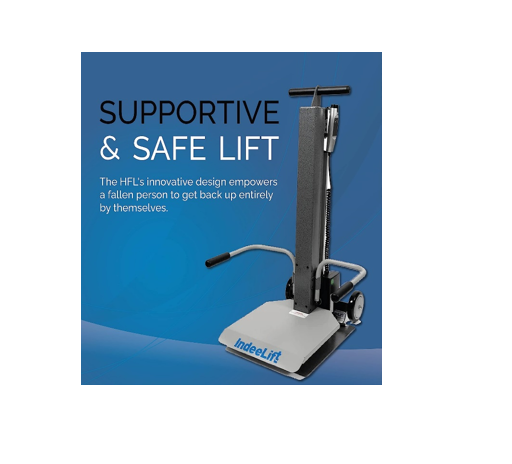This article welcomes you to the world of enhanced mobility and care with the best patient lifts in the market. As the demand for safe and efficient transfer solutions continues to rise, these state-of-the-art devices are revolutionizing the way we assist individuals with limited mobility.
Designed to ensure utmost comfort and security for both patients and caregivers, these top-notch lifts boast cutting-edge technology, robust construction, and user-friendly features.
Whether for home use or healthcare facilities, join us as we explore the leading options that redefine patient transfer, providing a newfound sense of independence and peace of mind for all involved.
What Are Patient Lifts?
Patient lifts are mechanical devices designed to assist caregivers in transferring and moving individuals with limited mobility.
They are commonly used in hospitals, nursing homes, and home care settings to lift and transfer patients safely and comfortably.
Patient lifts come in various forms, but they generally consist of a frame or chassis, a lifting mechanism, and slings or harnesses that support the patient during the transfer process.
There are two primary types of patient lifts:
- Manual Patient Lifts: caregivers using manual power, usually through a hydraulic pump or a winch system, operate these lifts. They require physical effort from the caregiver to lift and lower the patient.
- Powered Patient Lifts: they are electrically powered, lift, and lower the patient using a motor. They are easier to operate and require less physical exertion from the caregiver.
Patient lifts are essential for individuals who have difficulty standing, walking, or supporting their weight.
They help prevent injuries to both patients and caregivers during transfers and provide a sense of security and dignity to those who need assistance with mobility.
What to Consider When Buying Best Patient Lifts In the Market
Several essential factors should be considered to ensure you choose the most suitable and safe equipment for your needs. Here are some key considerations:
Weight Capacity
Determine the maximum weight capacity of the patient lift to ensure it can safely accommodate the weight of the patient you intend to transfer. Consider potential future needs as well.
Type of Patient Lift
Decide whether a manual or powered patient lift is more suitable for your requirements. Powered lifts are easier to operate but require a power source, while manual lifts may require more effort from caregivers.
Lifting Mechanism
Check the lifting mechanism, such as hydraulic, electric, or manual, to ensure it aligns with the level of effort you and other caregivers can comfortably manage.
Design and Features
Look for user-friendly controls, intuitive design, and essential features like emergency stop buttons, adjustable height, and easy-to-clean materials.
Size and Portability
Consider the size of the patient lift, especially if you have space constraints. Some models are foldable or have a compact design for easy storage and transportation.
Safety Features
Ensure the patient lift has safety features such as locking mechanisms, anti-sway systems, and secure attachment points for slings or harnesses.
Sling Options
Check the availability of different sling types and sizes to ensure the patient’s comfort and proper support during transfers.
Battery Life (if applicable)
If you are considering a powered patient lift, assess the battery life and charging time to avoid interruptions during critical transfers.
Durability and Quality
Research the reputation of the manufacturer and read reviews to gauge the quality and durability of the patient lift.
Compliance and Certifications
Verify that the patient lift meets industry standards and certifications for safety and quality.
Training and Support
Consider the availability of training materials and customer support to ensure proper use and maintenance of the patient lift.
Budget
Set a budget and explore options that fit within your financial constraints while still meeting your requirements for quality and safety.
Trial and Warranty
If possible, try out the patient lift before purchase to assess its ease of use and comfort. Also, check the warranty coverage to safeguard against potential defects or malfunctions.
By carefully evaluating these factors, you can make an informed decision and select the best patient lift that meets the specific needs of the patient, the caregivers while ensuring safety and efficiency during transfers. We hope the following list will guide in doing just that:
Best Patient Lifts in the Market
1)ProHeal Sit to Stand Patient Transfer Lift
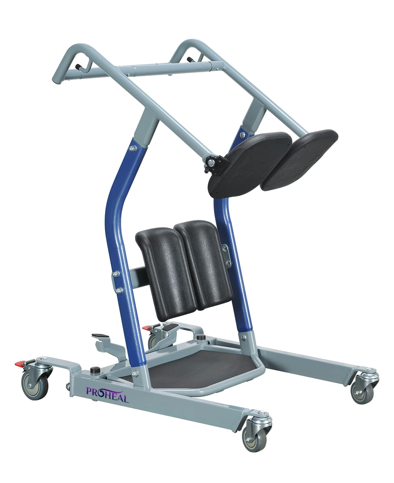
Coming first on this list is ProHeal Stand Assist Lift for those looking for patients lifts that also help in their transportation then this patient lift is worth your money.
Designed to help transfer patients who can stand enough to support 60-70% of their body weight, this stand assist prevents falls, increases safety for patient and caregivers, and provides more dignity than electric or hydraulic patient lifts.
The lift features hooks for optional side and support straps, dual rear locking casters (wheels) and easily adjustable locking base that increase safety. This standing assistance lift transfers patients between beds, wheelchairs, toilets, seats and more without the time and hassle of standard patient lifts.
Its ergonomic design is compatible with all slings and the lift has dual shin pads that offer extra support and comfort, foot pedal that offers hands free opening of base and the adjustable base provides clearance around recliners and other common obstacles.
Lastly, the equipment comes with a 3 Year warranty and its modular design allows for easy and affordable replacements.
Pros
- Good for variable range of patients
- Its study
- Easy to assemble
- Used as a stand assist
- Also doubles as transfer lift
- Durable
- Easy to use
- Supports up to 500 pound weight
Cons
- Not height adjustable
2) Fushida Hoyer Lift Medical Transfer Sling(Patient Lift Sling)

If you are looking for an affordable commode patient lift that will aid you and/or care giver to take care of your loved ones then Fushida Hoyer Lift Sling is one of the best.
This lift comes with high quality ample padded polyester mesh material which is ideal for bathing and toileting patients who are totally or partially dependent (elderly, disabled, handicapped or stroke patient), obese, non-weight bearing and patients who have limited control of their upper body.
It does not retain body heat if the patient must stay on the sling for extended periods. Hoyer commode lift measures 38.9in x 36in/ 93cm x 98.7cm without straps with a 200-500lb weight capacity.
Hoyer lift mesh sling also offers a wide opening, which provides toileting access and makes it easier to put on and take off a patient than a normal full body patient sling.
Pros
- Multiple uses
- Heavy duty Slings for Patient
- Affordable
- Washable
- Reusable
- Portable
- Easier to use
- Soft and comfortable
Cons
- No head support
- Do not come with a connection lift
3) MAIDeSITe Electric Chair patient Lift
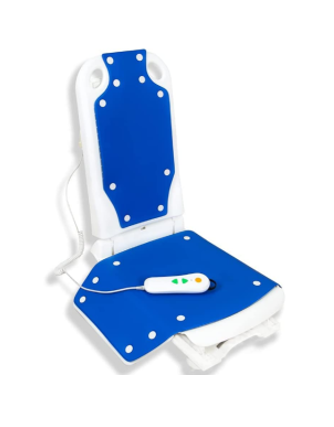
Third on the list is MAIDeSITe Electric Chair Lift that weighs 29 pounds. It is sturdy with high-strength supporting steel rod material that can hold up to 300lb and six suction cups at the base.
The manufacturer provides a returnable service for non-quality issues such as transit damages. The chair is made using stable high-strength steel rods as the support frame and easy to clean seat cushions making it safer and more comfortable to use.
In addition, it is waterproof, has two foldable side wings designed to move easily from the ground to the lift chair and is equipped with rechargeable batteries that have a longer battery life. It is important to note that when the hand control is charging, the indicator light will not light up.
Pros
- It is stable and study
- Easy to assemble
- The chair is comfortable
- Adapts to the requirements of most environments
- The battery holds charge for longer
- Has six suction cups for stability
- Easy to understand user guide
Cons
- Lacks indicator for remaining battery power.
4) 4-in-1 OasisSpace Mobility Assist Chair
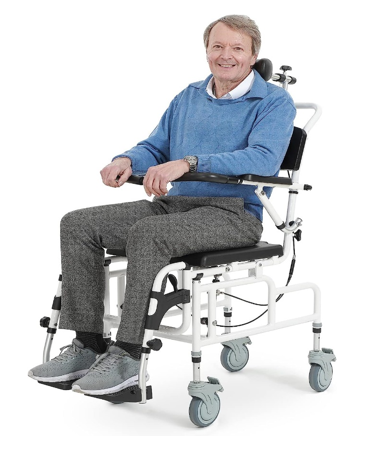
Next in the list is the OasisSpace reclining shower commode wheelchair with detachable bucket that is designed for elderly, disabled or people with impaired movement.
It has versatile application at hospital and home. With OasisSpace rolling shower chair, caregivers will not be worried about transferring the patience to shower stall any more. It can also help patients to shower or move independently.
Four-in-one ergonomically designed chair is made with durable PU material and anti-rust lightweight aluminum alloy, four silent PVC swivel wheels with foot brake that makes the chair move smoothly and stop safely.
The legs of toilet chair are height adjustable from 22’’ to 23.5’’ to fit with different height. The frame of chair with wheels is sturdy and supports up to 300lbs.
Pros
- Waterproof
- Durable
- Lightweight
- It’s a heavy duty transport rolling chair
- Can recline into a shampoo chair
- Easy to clean
- Bedside commode toilet chair
- Has height-adjustable headrest and footrest
- Easy to assemble
- Semi-surrounded handrails prevent users from forward leaning.
Cons
- Heavy
5) Lumex Stand Assist Patient Lift
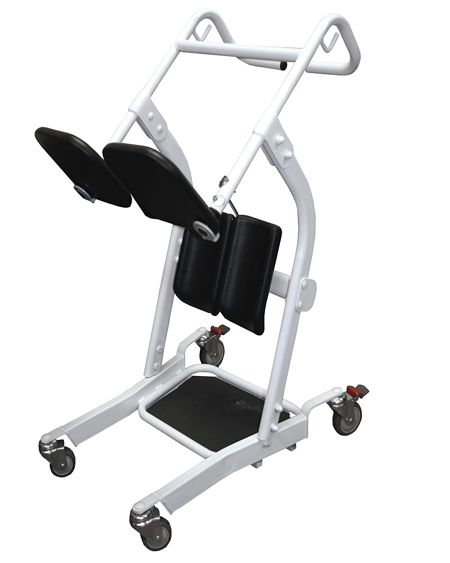
Attain effortless patient lift of up to 400 lbs. with Lumex LF1600 stand assist lift that provide transport assistance to individuals with a height of between approximately 5’1″ and 6’6″.
It is designed with compact narrow frame that fits through most doorways and enables easy navigation around the home.
The lift measures 33.5 x 25 x 42.5 inches and weighs 61 Pounds hence can and positioned close to furniture.
This lift’s cushioned kneepads and seat are ergonomically shaped and padded to fit users’ body for maximum comfort. The casters roll smoothly and quietly over indoor surfaces such as carpet, tile, and wood floors.
Pros
- Encourages patient independence
- Versatile use
- Effortlessly lifts and transfers patients
- Sturdy frame
- Support Gait Training
- Ergonomic design
- Has emergency stop button
- Provides safety for patients and caregivers
Cons
- Users must be able to actively participate and/or partially support their weight
You may also like
6 best portable oral irrigators
best hearing aids in the market for senior citizens
8 best medical scooters for broken foot
Best Grab Bars for the Seniors
Benefits of Best Patient Lifts in the Market
The best patient lifts in the market offer numerous benefits that significantly improve the quality of life for both patients and caregivers. Some of these benefits include:
Enhanced Safety
The top-quality patient lifts prioritize safety during transfers, reducing the risk of accidents, falls, and injuries for both the patient and the caregiver.
They feature secure locking mechanisms, stable frames, and well-designed slings or harnesses that provide optimal support.
Ease of Use
Leading patient lifts are designed with user-friendliness in mind. They come equipped with intuitive controls, smooth operation, and easy-to-understand instructions, making them accessible to caregivers of all experience levels.
Comfort for Patients
These lifts incorporate features that ensure patient comfort throughout the transfer process. The slings or harnesses are often padded and ergonomically designed to minimize pressure points and discomfort.
Reduced Strain on Caregivers
Powered patient lifts, in particular, significantly reduce the physical strain on caregivers during transfers. The electric motor does the heavy lifting, allowing caregivers to focus on providing proper support and care.
Versatility
The best patient lifts are versatile and can accommodate various transfer scenarios, including bed to chair, chair to commode, and floor to bed, among others.
This adaptability is essential for meeting the diverse needs of patients with varying mobility levels.
Improved Independence
By facilitating safe and smooth transfers, patient lifts promote a sense of independence for individuals with limited mobility.
They allow patients to participate more actively in their daily activities and enhance their overall well-being.
Time and Cost Efficiency
Investing in a high-quality patient lift can lead to long-term cost savings by reducing the need for additional caregiver assistance and minimizing the risk of injuries and subsequent medical expenses.
Hygiene and Infection Control
The best patient lifts often feature easy-to-clean materials and smooth surfaces, ensuring proper hygiene and infection control in healthcare settings.
Durability and Reliability
Top-tier patient lifts are built with durable materials and undergo rigorous testing, ensuring their longevity and reliability in demanding environments.
Compliance with Regulations
Reputable patient lift manufacturers adhere to safety standards and regulations, providing peace of mind to users knowing that the equipment meets industry requirements.
Safety Measures to Consider While Using Best Patient Lifts In The Market
Using patient lifts safely is of utmost importance to prevent accidents or injuries during transfers. Here are some essential safety measures to follow while using the best patient lifts in the market:
Proper Training
Caregivers should receive thorough training on how to operate the specific patient lift model they are using.
Training should cover proper assembly, safe lifting techniques, correct sling and harness attachment slings together with emergency procedures.
Weight Capacity
Always ensure that the patient’s weight does not exceed the maximum weight capacity of the lift. Exceeding the weight limit can compromise the lift’s stability and lead to accidents.
Pre-transfer Assessment
Before attempting any transfer, assess the patient’s condition and check for any contraindications that may affect the safe use of the patient lift.
Check Equipment
Regularly inspect the patient lift for any signs of wear, damage, or malfunction. Ensure that all components, including straps and hooks, are in good condition and functioning properly.
Secure Slings/Harnesses
Always ensure that the slings or harnesses are securely attached to the patient lift’s lifting mechanism. Follow the manufacturer’s instructions for attaching and adjusting the slings to ensure proper support during transfers.
Correct Patient Positioning
Position the patient correctly in the sling or harness to distribute their weight evenly and prevent discomfort or instability during lifting and transferring.
Use Brake/Locking Mechanism
Engage the brakes or locking mechanism on the patient lift when it is not in use or during transfers to maintain stability and prevent accidental movements.
Clear Pathways
Before initiating a transfer, ensure that the pathway is clear of obstacles and hazards that could interfere with the movement of the patient lift.
Avoid Overhead Hazards
Be cautious of overhead hazards, such as ceiling fans or lights, when using powered patient lifts to avoid potential collisions.
Clear Communication
Maintain clear communication with the patient during the transfer process. Inform them about the movements you are going to make and instruct them on how to cooperate safely.
Avoid Sudden Movements
Move the patient lift smoothly and avoid sudden or jerky movements to prevent discomfort or injuries.
Two-Person Transfers
Transfers that require additional support or involve complex movements, consider using two caregivers to ensure patient safety.
Emergency Stop
Familiarize yourself with the emergency stop button or lever on powered patient lifts and be prepared to use it in case of any issues or emergencies.
Follow Manufacturer’s Guidelines
Always adhere to the manufacturer’s instructions, guidelines, and safety recommendations for the specific patient lift model you are using.
By following these safety measures, caregivers can ensure the well-being of both patients and themselves during transfers, making the use of patient lifts a secure and effective means of mobility assistance.
FAQs for Best Patient Lifts In The Market
How can I be trained on using a patient lift?
Many suppliers or manufacturers provide training materials and resources to assist caregivers in learning how to operate patient lifts safely and effectively.
Additionally, some may offer in-person or online training sessions for proper usage and maintenance.
Can patient lifts be used for different transfer scenarios?
Yes, most patient lifts are designed to be versatile and are used for various transfer scenarios, such as bed to chair, chair to commode, floor to bed, and more.
However, always check the manufacturer’s guidelines and the lift’s specific features to ensure it is suitable for your intended use.
Are there different sling options available for patient lifts?
Yes, patient lifts often come with different sling options, including various sizes and designs to accommodate the patient’s needs and preferences. Make sure the sling you choose provides adequate support and comfort for the patient.
Conclusion
In conclusion, the best patient lifts in the market represent a remarkable advancement in mobility assistance, providing unmatched safety, convenience, versatility and comfort for both patients and caregivers.
With their innovative designs, user-friendly features, and adherence to stringent safety standards, these lifts redefine patient transfer, offering a newfound sense of independence and dignity to individuals with limited mobility.
Whether in healthcare facilities or home care settings, the top-tier patient lifts contribute significantly to enhancing the overall quality of life for those in need of assistance.
By carefully considering factors such as weight capacity, lifting mechanism, safety features, and warranty, individuals can confidently select the most suitable patient lift to meet their unique requirements.
With the best patient lifts at their disposal, caregivers can carry out transfers with ease, knowing that they are providing optimal care and support to their patients.

